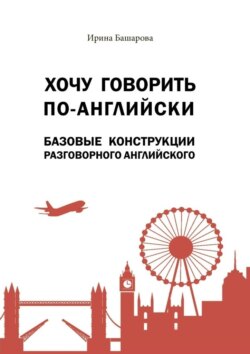Читать книгу Хочу говорить по-английски: базовые конструкции разговорного английского. Учебное издание - Ирина Башарова - Страница 6
Множественное число существительных
What are these?
ОглавлениеКонструкцию единственного числа превращаем в конструкцию множествен- ного числа: Это стол. Это столы.
+ These are (= these’re) tables. (Это столы.)
– These are NOT (=these’re not) tables. (Это не столы.)
?Are these tables? (Это столы?)
2 раза читаем, 3 раза повторяем по памяти:
This is a boy. a boy
This is a girl. a girl
This is a bird. a bird
This is a hat. a hat
– X, – S, -SS
a box – boxes (коробка) (коробки) a bus – buses
(автобус) (автобусы) a glass – glasses (стакан) (стаканы)
Существительные на… согласную + y
a fly – flies
(муха) (мухи)
an army – armies (армия) (армии) a lady – ladies (дама) (дамы)
boys These are boys
girls These’re girls
birds These’re birds
hats These’re hats
– F, -FE
a shelf – shelves (полка) (полки) a knife – knives (нож) (ножи) a wife – wives (жена) (жены)
a man => men (мужчина) (мужчины) a woman => women (женщина) (женщины) a child => children (ребенок) (дети)
Абсолютные исключения:
a deer => deer
(олень) (олени)
a mouse => mice (мышь) (мыши) a goose => geese (гусь) (гуси)
a tooth => teeth
(зуб) (зубы) a sheep => sheep (овца) (овцы) a louse => lice (вошь) (вши)
Повторяем предложения 5 раз, схема 2/3:
These’re boys. These’re 3 boys. These’re 3 women. These’re not men. These’re 2 shelves. These’re not tables.
These’re pencils. These’re not pens. (ручки)
These’re 5 children and 3 women. These’re not men. These’re birds. These’re not flies.
Are these knives? – No, these’re not knives. These’re glasses. Are these boxes? – Yes, these’re 4 boxes.
Are these geese? – No, these’re not geese. These’re mice. What are these? – These’re sheep, 9 sheep.
What are these? – These’re hats, 2 hats. What are these? – These’re 7 birds and flies. This is a man. – These’re men. ц
This is a woman. – These’re women. This is a child – These’re children This is a fly. – These’re flies.
This is a knife. – These’re knives. This is a deer. – These’re deer.
This is a mouse. – These’re mice.
Lesson 3
Предлоги места
Where is (are)?
The (сокращенное от this – это) употребляется перед существительным и во множественном и в единственном числе;
(под) (напротив)
Автоматизируем каждое предложение 5 раз, схема 2/3:
Where is (are) …? – Где (что-то) находится?
(ед. ч.) (мн. ч.)
This is a room. This is a table.
Where is the table? – The table is in the room. This is a shelf. These are books.
Where are the books? – The books are on the shelf. This is a ball. This is a chair.
Where is the ball? – The ball is behind the chair. This is a box. This is a book.
Where is the book? – The book is in the box. This is a girl. This is a table.
Where is the girl? – The girl is at the table. This is a cat. This is a table.
Where is the cat? – The cat is under the table. This is a table. This is a chair.
Where is the chair? – The chair is in front of the table. This is a house. This is a school.
Where is the house? – The house is near the school.
4)
home (дома) school (в школе) work (на работе)
The children are at school. The men are at work.
The women are at home.
Читаем и произносим:
– One
– two
– three
– four
– five
– six
– seven
– eight
– nine
– ten
Схема 2/3:
– Eleven
– twelve
– thirteen
– fourteen
– fifteen
– sixteen
– seventeen
– eighteen
– nineteen
100 Hundred
20 twenty
30 thirty
40 forty
50 fifty
60 sixty
70 seventy
80 eighty
90 ninety
5 balls in the room, 16 boys in the room, 12 books on the shelf, 30 boxes on the table, 3 boxes under the chair, 17 boys at school, 11 girls at school, 8 men at work,
9 women at home.
Теперь самостоятельно по-английски:
Школа (находится) рядом с домом.
Кошка – под столом. Книги – на полке.
Мячик – за стулом. Коробка – на столе.
Книга – в коробке. Стул (стоит) напротив стола. Птицы – на дереве (on the tree). Женщины (стоят) у дома.
